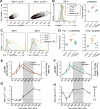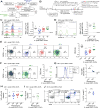Germinal Center Selection and Affinity Maturation Require Dynamic Regulation of mTORC1 Kinase
- PMID: 28636954
- PMCID: PMC5526448
- DOI: 10.1016/j.immuni.2017.06.005
Germinal Center Selection and Affinity Maturation Require Dynamic Regulation of mTORC1 Kinase
Abstract
During antibody affinity maturation, germinal center (GC) B cells cycle between affinity-driven selection in the light zone (LZ) and proliferation and somatic hypermutation in the dark zone (DZ). Although selection of GC B cells is triggered by antigen-dependent signals delivered in the LZ, DZ proliferation occurs in the absence of such signals. We show that positive selection triggered by T cell help activates the mechanistic target of rapamycin complex 1 (mTORC1), which promotes the anabolic program that supports DZ proliferation. Blocking mTORC1 prior to growth prevented clonal expansion, whereas blockade after cells reached peak size had little to no effect. Conversely, constitutively active mTORC1 led to DZ enrichment but loss of competitiveness and impaired affinity maturation. Thus, mTORC1 activation is required for fueling B cells prior to DZ proliferation rather than for allowing cell-cycle progression itself and must be regulated dynamically during cyclic re-entry to ensure efficient affinity-based selection.
Keywords: B cell; antibody; cell cycle; cell size; germinal center; mTOR.
Copyright © 2017 Elsevier Inc. All rights reserved.
Figures







Comment in
-
The TORC that Gets the GC Cycling.Immunity. 2017 Jun 20;46(6):974-976. doi: 10.1016/j.immuni.2017.06.003. Immunity. 2017. PMID: 28636966
References
-
- Aagaard-Tillery KM, Jelinek DF. Inhibition of human B lymphocyte cell cycle progression and differentiation by rapamycin. Cell Immunol. 1994;156:493–507. - PubMed
-
- Amati B, Alevizopoulos K, Vlach J. Myc and the cell cycle. Frontiers in bioscience : a journal and virtual library. 1998;3:d250–268. - PubMed
MeSH terms
Substances
Grants and funding
LinkOut - more resources
Full Text Sources
Other Literature Sources
Molecular Biology Databases
Miscellaneous

